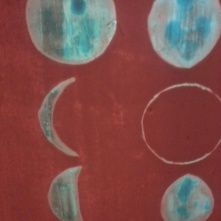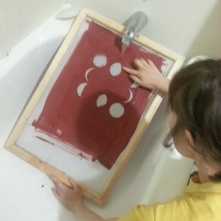Cheryl Geisler “How Ought We to Understand the Concept of Rhetorical Agency?”
A Report from ARS (Alliance of Rhetoric Societies now part of Rhetoric Society of America), 2004
Author Info
Cheryl Geisler is Professor of Interactive Arts and Technology at Simon Fraser University where she serves as the inaugural Dean of the Faculty of Communication, Art and Technology. Geisler has written extensively on the nature of texts, especially those mediated by new technologies A recognized expert on verbal data coding, she is the author of Analyzing Streams of Language and leads an annual international workshop on verbal data analysis. Her research interests include advancement of women in the academy, technologies of text and verbal data analysis.
Rhetorical E/Affect
As a technology ultimately inspired by the second Great Awakening, the Ouija Board illustrates the anxiety surrounding our many fantasies about human agency, particularly in respect to communication as a transcendent, or even transparent event. (Ouija Board)
Geisler’s article sparked a response from Christian Lundberg and Joshua Gunn called “Ouija Board, are there any communications? Agency, ontotheology, and the death of the humanist subject, or, continuing the ARS conversation”. The abstract reads:
This essay responds to Cheryl Geisler’s “report” on the discussions about the concept of agency at the 2003 Alliance of Rhetorical Societies conference. We argue that Geisler’s report inaccurately and unfairly describes the wide-ranging positions discussed at the conference, particularly by collapsing subjectivity and agency and by advancing a strawperson argument about “postmodernism.” In contrast to the humanist understanding, we recommend and describe a negative theology of the subject that adopts a more hospitable posture of uncertainty toward the agent and agency.
They explain that “casting the problem of rhetorical agency as a rhetorical affect, instead of as a point of origin for rhetorical effect, requires us to think about the agent and its relation to agency as one trope among others that productively and destructively constrains the exercise of our critical imagination.” Agency, as production of effects, possesses and constitutes the agent—not the other way round.
To which Cheryl Geisler responded with “Teaching the post-modern rhetor: Continuing the conversation on rhetorical agency”. The abstract reads:
In responding to Gunn and Lundberg’s critique of her report on rhetorical agency, Geisler uses their Ouija Board metaphor to undertake an analysis of what it might mean to teach the post-modern rhetor. In particular, once the autonomous agent has been denaturalized, members of the profession of rhetoric have plenty to do in helping students first to engage with and then to participate in a more appropriately theorized rhetoric. Like the Ouija Board player, we may not be able to know how the results of our classroom teaching are related to our intentions. But–like every other rhetor–we need to recognize the costs of walking away from the game.
Summary
As rhetoricians, we generally take as a starting point that rhetoric involves action (12).
Geisler provides her account of the conversations taking place at Alliance of Rhetoric Societies that capture deliberation on the question “how ought we to understand the concept of rhetorical agency”? She maintains that without a concept of agency, we (rhetoricians) lack the necessary rationale for work (producing scholarship, social change, educating).
Inventory of Central Concerns
the idol/idle of the ideology of agency
impetus for meeting: deliberation of the future of rhetorical studies taking up the question “how ought we to understand the concept of rhetorical agency?”
- this a question of definition combined with a question of deliberation: Geisler accounts for this by describing it as an interplay between rhetoric’s interpretive project and rhetoric’s educational mission (9) and an interplay “between what rhetorical agency, in fact, is and what it, in value, ought to be” (9)
- “Most scholars at the ARS acknowledged, explicitly or implicitly, that recent concern with the question of rhetorical agency arises from the post-modern critique of the autonomous agent” (10)
- traditional rhetoric as ideology of agency: speaker as origin, strategy as intentional, discourse as constitutive of character and community, ends that bind in common purpose
- issues of access to agency, the varieties of agency, available means
extending the traditional rhetor
cites advances developing agency happening in:
- how rhetorical agency functions in subaltern social groups (those who do not have access to mainstream public forums) – the exercise of agency by rhetors without taken for granted access (11)
- interplay of audience and media (iconic photographs) in networks of constructing and being constructed (11)
- digital technologies that alter human experience of space and thus the sense of human potential or agency (11)
constructing agency through connections of (human) condition
she explains that the critique of the ideology of agency is concerned with the link between rhetorical action and social change—the actions of a rhetor and consequences in the world (12)
critique of agency as illusionary isn’t productive because it dissolves the connection between action and effect/change
she explains that it is more productive to:
- think of agency as a resource constructed in particular contexts in particular ways
- consider how various political systems figure agency
- consider agency not a problem to be re/solved or troubled but a central object of rhetorical inquiry
- look at the way material conditions shape rhetorical action (by which a communicative act materializes out of a combination of individual will and social circumstances 14)
skill of the rhetorical agent
- rhetorical agency manifests when a speaker/writer displays an ability to “identify and manage or…orchestrate resources” (13)
- a conscious structuring of one’s message to maximize possibilities of evoking
- “only if we can assent to the role of the rhetoric in producing efficacious action can we as a discipline have a mission to educate such rhetors to have agency” (13)
duty now for the future
- “the term agency has moved from marking off the unnoticed foundation for efficacious rhetorical action to opening up its mechanisms” (14)
- move from universal construct to the specific local and historical conditions that undergird it
- need to acknowledge that agency is not universally available to all members of society
rhetorical agency a rhetoric makes
the traditional model of humanist agent as addressing “the elephant in the room”—the tie between the mission of rhetoric and the concept of rhetorical agent; “a rhetorical agent seen to make choices among the available means of persuasion is an agent rhetoricians can educate to the best choices” (15)
“How can we create a better society through the pursuit of rhetoric?” (15)
- can tap into unacknowledged resources of body, space, and so on of subaltern groups
- abandon rhetoric’s social mission—”but would we be doing rhetoric anymore?”—in admitting that agency is illusionary
Discussion
- “how can rhetoric be understood to suffuse the entire situation if its traditional definition largely confines it to the perspective (and symbolic)activity of human subjects” (Thomas Rickert, “Circumnavigation” 3)?
- what/who is lost in focusing on what agency is (the subject of rhetoric) instead of how agency is—its <affect> <effect>?
 Casey Boyle and Nathaniel Rivers, in discussing the pervasive nature of podcasts and the unmoored state of being of rhetoric from any particular object; how can agency be sensed differently?
Casey Boyle and Nathaniel Rivers, in discussing the pervasive nature of podcasts and the unmoored state of being of rhetoric from any particular object; how can agency be sensed differently?
Images (from left to right): Selection of transcript from “The Pod(cast) People Speak” featuring Casey Boyle and Nathaniel Rivers // “The Speech of Things” // “A Bot Bought Illegal Drugs and No One’s Sure What to Do About It“













